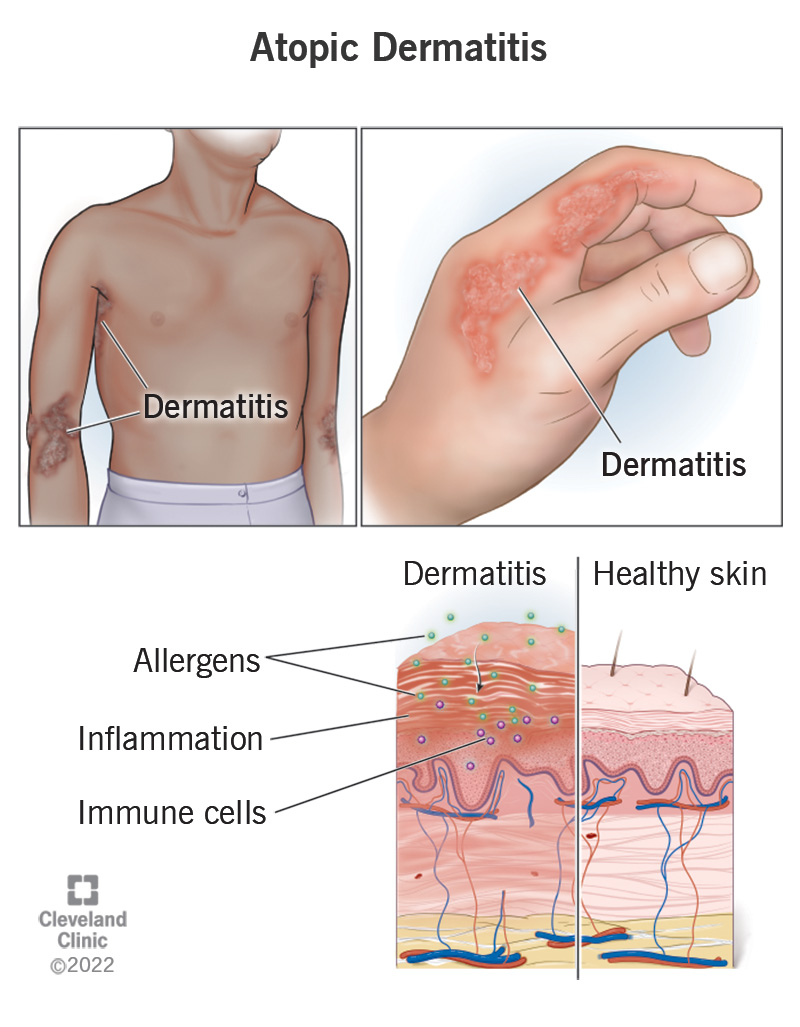Atopic dermatitis is a skin condition that causes discoloration and itchy rashes. It usually begins in childhood, and flare-ups can continue on through adulthood. There’s no cure for atopic dermatitis, but the condition can be managed with proper care. Treatment options include corticosteroid creams, antihistamines and prescription medications.

Atopic dermatitis is a chronic condition that causes itchy skin that gets dry and scaly. It tends to come and go and may only be in childhood or may affect you your entire life. In people with light-colored skin, atopic dermatitis looks like red rashes. People with darker skin may develop brown, purple or gray rashes.
Advertisement
Cleveland Clinic is a non-profit academic medical center. Advertising on our site helps support our mission. We do not endorse non-Cleveland Clinic products or services. Policy
Dermatitis and eczema both refer to inflammation of the skin. Eczema is a broad, umbrella term describing a group of conditions. Atopic dermatitis is the most common type of eczema.
Atopic dermatitis is most common in children, but it can occur at any age. The condition affects people assigned male at birth (AMAB) and people assigned female at birth (AFAB) in equal numbers. Black people are slightly more likely to develop the condition compared to white people. Of all the people affected by atopic dermatitis, 65% develop the condition within the first year of life, while 90% develop the condition before age 5.
Advertisement
The condition is quite common. Approximately 1 out of every 10 babies and young children develops symptoms of atopic dermatitis. Almost two-thirds of those affected continue to have flare-ups on into adulthood.
It’s common for atopic dermatitis to develop in areas where the skin bends or flexes, like behind your knees or on the inside of your elbow. But it can occur anywhere, including your:
Advertisement
Symptoms can vary significantly from person to person, and they can range from mild to severe. Common atopic dermatitis symptoms include:
Atopic dermatitis is multifactorial, meaning there isn’t just one cause, but many possible causes. It happens when your skin’s barrier function gets damaged. This results in skin that’s more sensitive and vulnerable to irritants, allergens and other environmental factors. When you come into contact with an irritant or allergen that triggers symptoms, it’s called contact dermatitis.
Many food allergens can trigger atopic dermatitis. Some of the most common include peanuts, tree nuts, eggs, soy, cow’s milk, wheat, shellfish and seafood.
No. Even if you have an active rash, atopic dermatitis isn’t contagious. Keep in mind, however, if your rash starts to weep, it may mean you have an infection. If this occurs, it may be possible for the infection to spread to other people through physical contact.
Your healthcare provider will examine your skin and review your medical and family history. In some cases, they may perform a skin or blood test to be sure of the diagnosis.
There are several medications and therapies that can help manage atopic dermatitis symptoms. These include:
Children will sometimes outgrow atopic dermatitis, or have flares that are less severe over time. Though atopic dermatitis isn’t curable, it’s manageable with the right treatments. Most people can reduce their symptoms by using moisturizing creams at least twice daily. Even if you’re diligent in your skincare routines, you can still experience flare-ups. Therefore, it’s important to know how to manage your symptoms when they come back.
To soothe inflamed skin and reduce itching:
While you can’t prevent atopic dermatitis altogether, you can take steps to reduce your risk of flare-ups. To do this, avoid any possible triggers and keep your skin thoroughly moisturized.
Atopic dermatitis won’t go away completely. But once you find ways to properly manage your symptoms, your flare-ups likely won’t be as severe. People with atopic dermatitis should check in with their healthcare provider regularly, depending on the frequency of flares, to ensure they’re using the best treatments available.
You should call your healthcare provider if your condition causes pain or discomfort, or if it keeps you from sleeping or functioning normally. If your rash begins to weep, or if you develop raised, fluid-filled bumps, schedule an appointment with your provider.
A note from Cleveland Clinic
While atopic dermatitis isn’t typically dangerous, it can wreak havoc on your comfort and quality of life. Fortunately, there are several treatments available to help keep your symptoms in check. Most people experience a dramatic improvement once they find a skincare regimen that works for them.
Last reviewed on 10/17/2022.
Learn more about the Health Library and our editorial process.
Advertisement
Cleveland Clinic is a non-profit academic medical center. Advertising on our site helps support our mission. We do not endorse non-Cleveland Clinic products or services. Policy